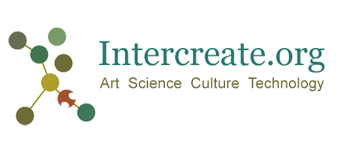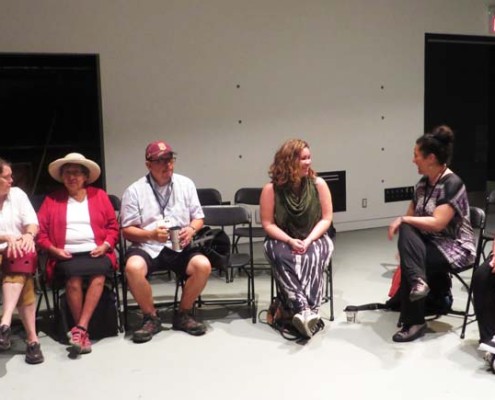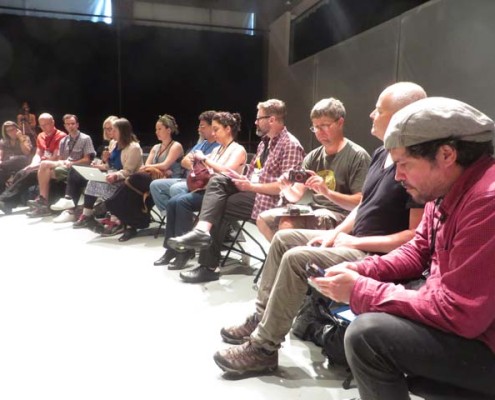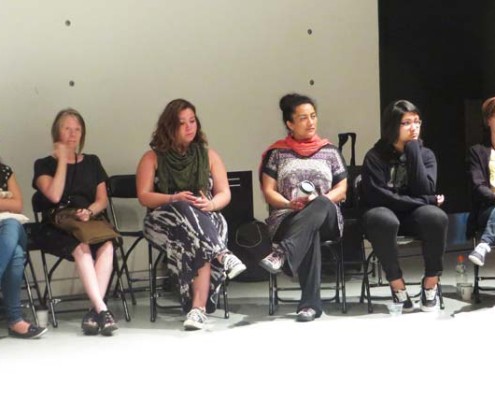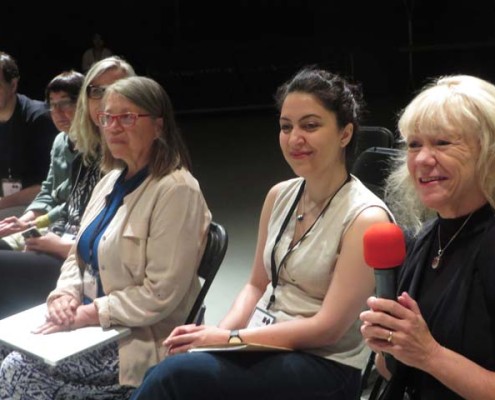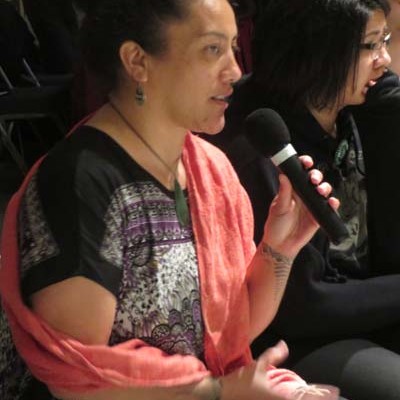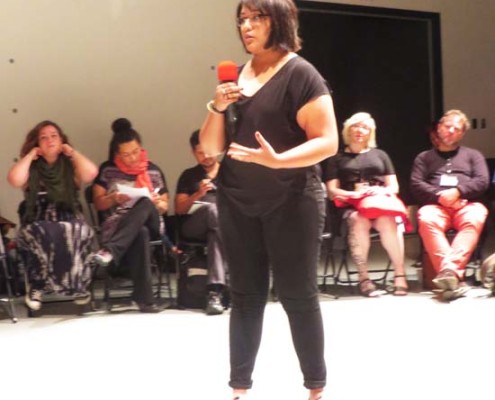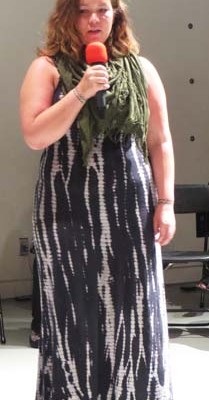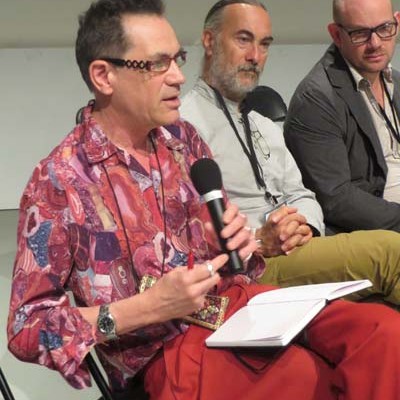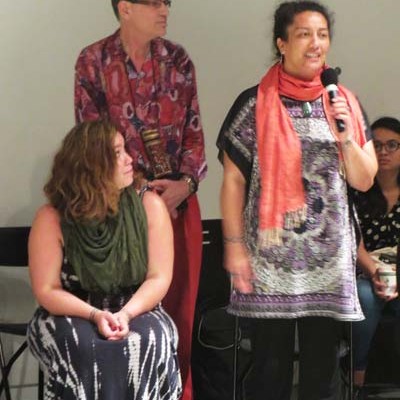Report on The Value of Knowledge Transfer Education Forum at ISEA2015 Vancouver
About the Forum
The concept of The Value of Knowledge Transfer by selected representatives of the global indigenous community, was proposed by Nina Czegledy to the ISEA2015 team at ISEA2014 in Dubai.
This was to be the first participatory interdisciplinary, inter-generational, international indigenous session in the history of ISEA. There have been previous panels consisting of indigenous representatives at ISEA2011 and 2012, however 2011 did not have multiple indigenous representation and neither were interdisciplinary. Consequently it was very important to select outstanding presenters relating their own personal views and experiences, working in the area under discussion.
The speakers drew upon indigenous peoples worldwide and included local Elder Margaret Rose George of the Unceded Coast Salish peoples. Other speakers were: Jo Tito, Maori Artist, New Zealand; Ninabah Winton, Navajo Artist, US; Stacey Aglock, Inuit Artist, Nunavut; Eldon Yellowhorn, Chair First Nations Studies/Associate Professor, Archaeology, Piikani First Nation; Jenna Walsh, Indigenous Initiatives Librarian at Simon Fraser University; Sandra Semchuk photographer, Associate Professor, Emily Carr University of Art and Design, Canada and myself – Ian Clothier, hybrid Polynesian Artist, Executive Director Intercreate, ISEA International Board Member, Aotearoa New Zealand. Nina Czegledy, artist-scientist, curator, Intercreate Chair, Canada and Hungary was primary organiser of the entire event with local support from Tyler Fox; she also steered the discussion on the day. It is a measure of Nina Czegledy’s energy that she brought off this extraordinary gathering within a one year time frame.
The Forum
On August 19th we sat in the round to better facilitate discussion. All presentations were verbal, with visuals by the participants projected in the break. A video recording was taken particularly for those unable to attend, and will be placed online in due course.
Margaret Rose George offered welcome and asked us to consider future generations. Director of ISEA2015 Thecla Schiphorst then welcomed the participants. I spoke on behalf of the ISEA International Board and Nina Czegledy gave a brief introduction along with co-organiser Tyler Fox.
Eldon Yellowhorn of Blackfoot origin was the first presenter. An archaeologist, he has researched Blackfoot heritage and currently is the Dean of the First Nation program which he established at Simon Francis University. Eldon is extremely concerned about loss of native languages and inadequate documentation. He has combined a concern for social justice with the use of communication technologies (e.g. YouTube) in order to assist preserving oral traditions.
Jo Tito presented next. She opened her presentation in te Reo (Māori language) and sung a beautiful song as is customary, setting a great example for the spontaneous mode of the Forum. Jo’s creative art work is a collaboration with nature. She uses photography, paint and digital media to connect nature and technology. She spoke of connection to the whenua (land) and interconnection to the universe, addressing photosynthesis within the framework of Rakau in Māori. As a statement of her commitment to the forum she raised her own funds to travel from Aotearoa New Zealand and is grateful to those who assisted her.
Ninabah Winton is an emerging Navajo artist currently studying Digital Culture at the School of Arts, Media, and Engineering at Arizona State University. She talked about visibility and the difficulties of positioning oneself in our contemporary digital age. Knowledge transfer could occur through specific creative projects. In 2014, Winton served as Curator for The Indigenous Water Project including 12 videos of indigenous Americans talking about the importance of water. Thanks are due to Leah Barclay and Garth Paine of ASU for helping facilitate support for Ninabah’s participation.
Stacey Aglok is of the Canadian Nunavut peoples. She with other Inuit artists and cultural activists bridges the huge Arctic distances and cultural differences by co-writing, directing and producing films and broadcast television. Maintain tradition and language through the use of technology is a challenge. She talked of her people as having a natural relationship to creative culture and underlined Jo Tito’s comments about land – land for Nunavut includes everything – in, above and below. Stacey also raised her own funding to attend, again a statement of the importance of the forum and we thank her for this. It is hoped that Jo Tito and Stacy Aglok will collaborate, having met at SCANZ in Aotearoa New Zealand and now again on Canadian soil.
Jenna Walsh works at the Bennett, SFU Library on First Nation issues and projects. She referred to a rising sense of global indigeneity in contemporary world culture and spoke of a canoe carrying knowledge forward to future generations. In the library/archive structure, utilising digital technology that stores indigenous knowledge requires both open and closed forms of the information as some knowledge needs to be protected. There is an apparent antipathy between indigenous and Western knowledge in terms of sharing – the convention is that Western is wide open while parts of indigenous is protected. The rejoinder to this (as these writers see it) is that there is knowledge exclusion on both sides of the cultural border, which is a function of the specialisation of knowledge: papers in sub nuclear physics are largely unreadable by large sections of the populace; while some knowledge is preserved for initiates among indigenous peoples.
Stacey gave us a beautiful throat-song recital – songs for children – to conclude the first part of the Forum.
After the break, Sandra Semchuk responded with astute remarks to the points made by each presenter. Although of European origin, she was married to and collaborated extensively with her artist husband James Nicholas Cree on a variety of indigenous themes. She has great insight into a variety of existing difficulties, asking how profound was the impact of indigenous cultures on Western culture? She sought ethical and generational positions, pointing out that to speak to youth we must contextualise meaning in technology. We are grateful to Sandra for hosting Jo and Stacey and inviting us to her home after the Forum event, which was one of the highlights of ISEA2015.
In the second part of the Forum there was an intense participatory discussion. Given manufactured industrial culture stands in contrast to nature, do indigenous peoples see a path involving using digital technology? One response was to go and see the land.
The interrelationship between indigenous knowledge and science was raised with interconnections pointed out in regard to integrated systems and cosmological context, which are common to both. Discussion about how to proceed putting forward and working with indigenous peoples in the context of the globally nomadic ISEA and events that people might organise placed the ball largely in the court of academics in terms of how academic events can be made attractive to indigenous groups. This is quite problematic, but putting forward themes of direct interest to indigenous groups was seen as a way forward.
Such informal and lively discussion is of immense importance to the Forum and is an ongoing feature of each event, this being the eighth forum in the series.
In my concluding comments and remarks I attempted to draw together the various points made by speakers and in open discussion, rounding off the Forum. We parted after final comments including a song from Jo Tito and one final throat song from Stacey Aglok.
For many attending ISEA, this forum was one of the highlights. It was the only participatory indigenous peoples event at ISEA in 2015. To sit in a circle and participate in a session that involves singing is quite unusual at an academic conference. While many academics are committed to cultural inclusion and the breaking down of hierarchies, often the architecture of lecture spaces works against these notions. It is time that we all worked together to change some of our assumptions about how things are done. We may move outside of comfort zones (data projectors don’t really work well in circles), but that is a more realistic place to be in the light of intercultural relations and the enormous task at hand in regard to the human relationship to the environment.
